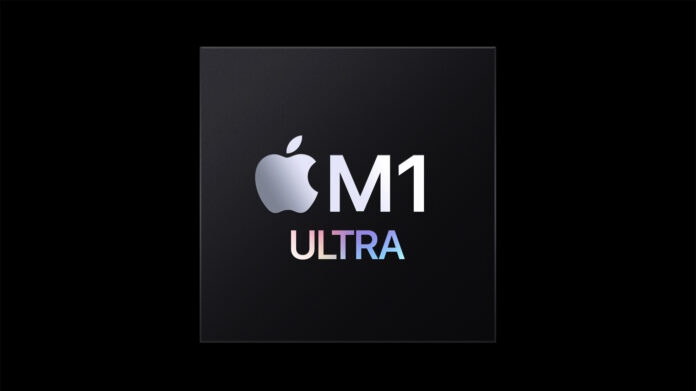Apple announces its new Mac Studio- a desktop PC with a processing chip that demonstrates highest processing speed and efficiency out there. M1 Ultra, as they call it, shall be a catalyst for Developers, Data Analysts, and anyone who is looking to speed their operations without having to input more power.
Apple achieves this superior processing performance through its Innovative Packaging Architecture- the UltraFusion. Using this very technique, Apple connected two dies of M1 Max chips, the latest ones before the M1 Ultra, and created a whole System on a Chip (SoC) architecture that carries all the necessary electronic circuitry for the Mac system including CPU, GPU, Neural Engine, and memory.
Though UltraFusion is a secret that is not yet divulged by the company, Apple calls it their magic behind the interconnection of two chips that intelligently combines performance levels for each individual chip.
.
M1 Ultra enables high gain for user applications through its SoC architecture which uses low power from the input to deliver intensive processing results. The number of transistors within this SoC are 114 billion, a figure that outnumbers any used earlier in PC chips.
To allow flexibility of user applications, Apple offers multiple configuration options in its M1 Ultra based Mac Studio such as selection of suitable memory, and a variety of processors such as CPU, GPU, and Neural Engine.
| RAM | 128 GB processor compatible, 800GB/s bandwidth, low latency, and unified memory design |
| CPU | 20 Core |
| GPU | 64 Core |
| Neural Engine | 32 Core |
Another feature of interest by the M1 Ultra chip is that it carries a unified memory design which means a single memory would be used for both CPU and GPU operations making the chip to achieve exceptional performance.
For those wanting to accelerate their intensive graphic processing needs such as in game development or people from film-making industry, the 64-core GPU will serve the purpose and enable an environment which wasn’t possible before.
And for the data analysts who are anticipating a boost in their ML and neural network operations shall opt for a 32-core Neural engine allowing promising speed in optimization and training process.
Now let’s see what Apple’s officials have to say about this breakthrough record in the PC industry. Talking about the features of Apple’s M1 chips, Johny Srouji, company’s senior vice president of Hardware Technologies says:
“With its powerful CPU, massive GPU, incredible Neural Engine, ProRes hardware acceleration, and huge amount of unified memory, M1 Ultra completes the M1 family as the world’s most powerful and capable chip for a personal computer.”
Just so that you know, Apple has just recently announced manufacturing of its Chips from the self-owned platform the Apple Silicon meanwhile ending its supply contract with Intel. That’s why Mr Srouji also talks about their feat in PC industry, that is, the UltraFusion packaging:
“M1 Ultra is another game-changer for Apple silicon that once again will shock the PC industry. By connecting two M1 Max die with our UltraFusion packaging architecture, we’re able to scale Apple silicon to unprecedented new heights,”
Performance Specifications
Now, let’s explore what each configuration option in the new legendary M1 Ultra has to offer:
The CPU: The 20-core CPU consists of sixteen performance-boosting elements and four efficiency-boosting elements that can perform multithreaded parallel processing 90% faster than a normal 20-core CPU utilizing the same power.
Not only this, Apple reports that M1 Ultra’s Peak performance is reached with a parsimony of 100 watts than other PC chips in the market.
The GPU: M1 Ultra’s GPU also outperforms the similar core GPUs in the PC desktops category achieving peak performance with 200W less power utilization.
As of the M1 Ultra’s unified memory design, access to the memory is even more brisk now with an improved bandwidth of 800GB/s, intriguingly advanced than 80GB/s available chips.
Ginormous memory of M1 Ultra is another impressive feature which now allows compatibility of GPUs with 128GB of unified memory compared to earlier 48GB compatible memory chips. With this much real-time memory for a GPU, Apple invites industry artists to one-up their extreme 3D animation workloads.
The Neural Engine: Apple hasn’t forgotten one of their core audience, the Data Analysts who always seem in quest of efficient technologies to support their massive artificial neural networks requirements.
M1 Ultra solves the massive processing requirements of neural network processing by enabling 22 trillion operations in a second with their 32-core Neural Engine.
Not only this, there’s good news for video editors too as Apple’s ProRes- their proprietary video codec that captures massive quality-pixels in videos and occupy great memory resources, could now be handled easily through the M1 Ultra’s Neural Engine.
Here’s what Apple has to say about the chip’s fast ProRes processing ability:
“In fact, the new Mac Studio with M1 Ultra can play back up to 18 streams of 8K ProRes 422 video — a feat no other chip can accomplish.”
Apple also adds some of its custom services in the list such as multiple-display capability, state-of-art security, and Thunderbolt 4 connections.
Users can use the M1 Ultra capabilities in the new Mac Studio, the model is almost double the price than previous Mac Studio (carrying an M1 max) since the new M1 Ultra is a combination of two M1 Max chips.


